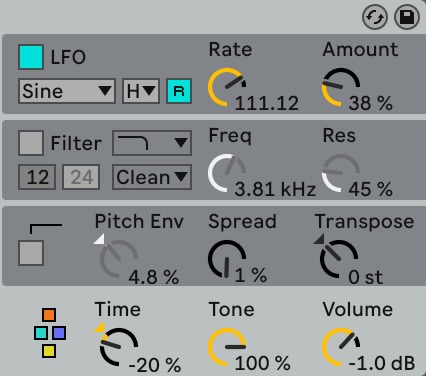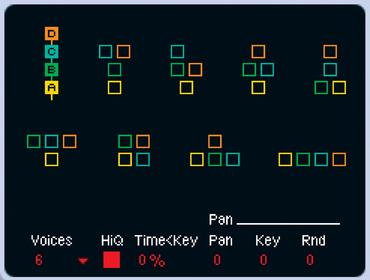Ableton Operator, the FM instrument designed by Robert Henke, is celebrating 20 years since its (internal) debut. Want to celebrate? How about a ton of FM synthesis and Operator history, 100 free presets from Robert Henke and Christian Kleine, and more links? And now is a great time to celebrate those years – or even try Operator sound design for the first time.

It was 20 years ago …
Designer and Abeton co-founder Robert Henke has posted a complete feature on Operator and its inspiration. That includes a nice general history of digital FM synthesis, from its genesis in John Chowning’s research. (Oddly enough, the mainframe Chowning used at the time was devoted to Stanford’s nascent AI program – even if Chowning was playing with sine wave oscillators, not artificial intelligence.) Robert also breaks down exactly what FM is and how it works.
Live had plug-in support, but all its sound generation capabilities were sample-based; Operator was set to become Ableton’s first synthesizer.
Dubbing it Onyx at the start, Robert prototyped Operator in Max/MSP. (It seems this story led to the mistaken belief that Live itself was prototyped in Max.) The concept was to create an accessible, flexible synth that would integrate well with Live and scale to computational resources of the era. (For reference, the PowerBook G4 15″ had just launched – but a lot of folks were still rocking 400 MHz G4 Titanium Apple laptops, or similar on the PC side.)
From Robert’s history:
The goal was simple: It should not be heavy on CPU (which ruled out good sounding analog modelling), it should offer a huge sonic palette, and it should be fun to program. I took a lot of inspiration from my DX27 as a starting point.
I know Robert told a later presentation that he also focused on 4-operator FM as manageable and intuitive. That makes sense; 4-op offers most of the flexibility of 6+-operator synthesis without the cognitive overhead and complexity. But it still opens up layering and nuance that you can’t get with just 2-op FM.
Maybe more interesting to note in retrospect is the way the team effort on Operator helped Ableton’s UI approach to evolve. Look at how much of what we now take for granted in Live debuted in Operator: the “LCD screen” for parameters, indicators for switches, switchable filter types, global time controls, and the graphic abstract representation of FM algorithms have all deeply impacted the DAW, its instruments and effects, and even third-party efforts. Operator was really a turning point for all of Live.
You’ll also notice how different the prototype was from Operator as it launched. Robert is quick to note the work of C++ implementation, feature management, and interface design all fell to the full team, including original graphic designer Torsten Slama. That should also give Max patchers license to go ahead and be crude with that first prototype, too. (Looking at it another way, what is contained in the prototype is a fascinating glimpse into what the core priorities were for the instrument.)

Robert, like Gerhard, often credits the Synclavier II as an inspiration, so there are notes about that. Also, I think this approach to Tone and modulation is especially worth highlighting:
When modulating a carrier with a modulator which either already contains a complex spectrum or has a high coarse frequency setting, the result can sound pretty harsh, due to aliasing.
To tame this, at the modulation input of each oscillator is a basic low pass filter. The original idea was to find one good sounding value and set it internally, but then I thought perhaps it is a good idea to have it as a control. Sometimes it is useful to have.
2004-2024 : Twenty Years of FM Synthesis inside Ableton Live
Free preset download
Ableton are offering a free “celebratory” pack of presets for Live as an alp file – Ableton Live 12 Suite required. Christian I’ve covered over the years, as well, during his long-time service as Ableton’s instrument designer.
20 Years of Operator: Download over 100 Free Presets from Robert Henke and Christian Kleine
A tidbit on Christian:
One feature Christian Kleine – then working in Ableton’s Support department – helped implement was the Osc<Vel control, which allows for the pitch of each oscillator to be controlled by velocity.
What we said in 2005
If you want the public birthdate of Operator, it’s not September 2024 but January 20, 2005. It was the first-ever standalone product to be sold outside of Live itself, and launched for $149 alongside bug fix release Live 4.1. (I even noted that was “a bit steep” – that’d be about $249 in 2024 dollars.)

Here’s what I wrote in 2005 in a review for Keyboard. (Somewhere, there’s the whole review, but not on the site any more.)
It sounds absolutely fantastic, it’s exquisitely well-documented and easy to use, really versatile, and all in a single-window interface that takes up a tiny portion of your screen. It’s no match for Native Instruments FM7 in synthesis power, but that’s a good thing: In contrast to FM7’s complex routing setup and multi-screen interface, Operator is easy to suss out and navigate — at half of FM7’s cost.
Funny enough, none other than Jesse Terry – the same Jesse Terry who now runs hardware at Ableton – reviewed Operator for Remix, saying:
“If you own Live 4, you probably already know about Operator and lust for it. If you don’t, it’s another reason to buy Live and add a great weapon to your sonic arsenal.”
CDM is also about to turn 20 years old, which means you can turn the time machine clock back to 2005 for more of the press take at the time.
Tutorials
Operator has proven an evergreen instrument for hardcore Live users, full of sound design possibilities for those ready to dive in. Let’s review just a few of those:
Francis Preve talking about translating natural sounds to Operator from the talk I hosted with him at Ableton Loop:
Here are a bunch of excellent Francis tutorials – downloads in the links:
I have more, but I realize I need to resolve some file links that are older than 15 years, and – uh, lol – references to Adobe Flash Player. Maybe I shouldn’t complain so much about publishers removing old content.
And more: